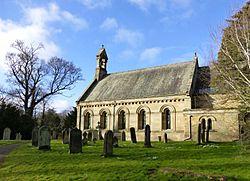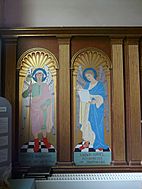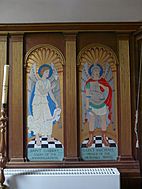St Michael and All Angels Church (Howick, Northumberland) facts for kids
Quick facts for kids St Michael's Church |
|
|---|---|
| St Michael and All Angels Church | |
 |
|
| 55°26′59.363″N 1°36′31.093″W / 55.44982306°N 1.60863694°W | |
| Location | Gardens of Howick Hall |
| Country | England |
| Denomination | Church of England |
| History | |
| Status | Parish church |
| Founded | c. 12th century |
| Dedication | Archangel Michael and all the angels |
| Architecture | |
| Functional status | Active |
| Heritage designation | Grade II |
| Designated | 31 December 1969 |
| Architect(s) | FJ Francis |
| Style | Neo-Norman and Romanesque |
| Completed | 1849 |
| Specifications | |
| Materials | Sandstone |
| Administration | |
| Archdeaconry | Northumberland |
| Diocese | Newcastle |
| Province | York |
St Michael and All Angels Church is a special church in the village of Howick, Northumberland, England. It's part of the Church of England and sits inside the beautiful gardens of Howick Hall. This church is a very old and important building. It's listed as a Grade II building, which means it's protected because of its history and beauty. About 20,000 people visit it every year!
A Look at the Church's History
The area around Howick has had a church for a very long time. Records show a priest named Asket here in 1158. But there was likely a church even before that!
Fires and New Buildings
The first church here was built in a style called Norman. This style uses strong, round arches. Sadly, that church burned down in 1746. A new building, which looked a bit like an ancient Greek temple, was built to replace it. But guess what? That one also burned down!
The church you see today was built in 1848. It was designed by an architect named FJ Francis. He chose a style called Neo-Norman, which looks like the old Norman style but was popular in the Victorian era. This church has round-arched windows and doors, just like the original Norman buildings. Francis made the church bigger by adding a chancel (the area around the altar) and a vestry (a room for the clergy). He also added a bell-cote, which is a small structure for bells.
The Grey Family Connection
The church has a strong connection to the Grey family, who lived at Howick Hall. Many members of this family are buried in the churchyard. The most famous person from the Grey family was Charles Grey, 2nd Earl Grey. He was the Prime Minister (the leader of the government) of the United Kingdom from 1830 to 1834.
During his time as Prime Minister, an important law called the Reform Act 1832 was passed. This law helped make the country more democratic, meaning more people had a say in how the country was run. But today, Charles Grey is probably best known for something else: the famous Earl Grey tea that carries his name!
The Grey family didn't just attend church; they also helped decorate it. Maria Copley, who was the 3rd Countess Grey, was a sculptor. She carved the gargoyles (stone carvings of strange creatures) that you can see on the outside north wall of the church. Later, Mabel Palmer, the 5th Countess, asked for paintings to be made behind the altar and near the baptismal font (where baptisms happen).
See also
 In Spanish: Iglesia de San Miguel y Todos los Ángeles (Howick) para niños
In Spanish: Iglesia de San Miguel y Todos los Ángeles (Howick) para niños



